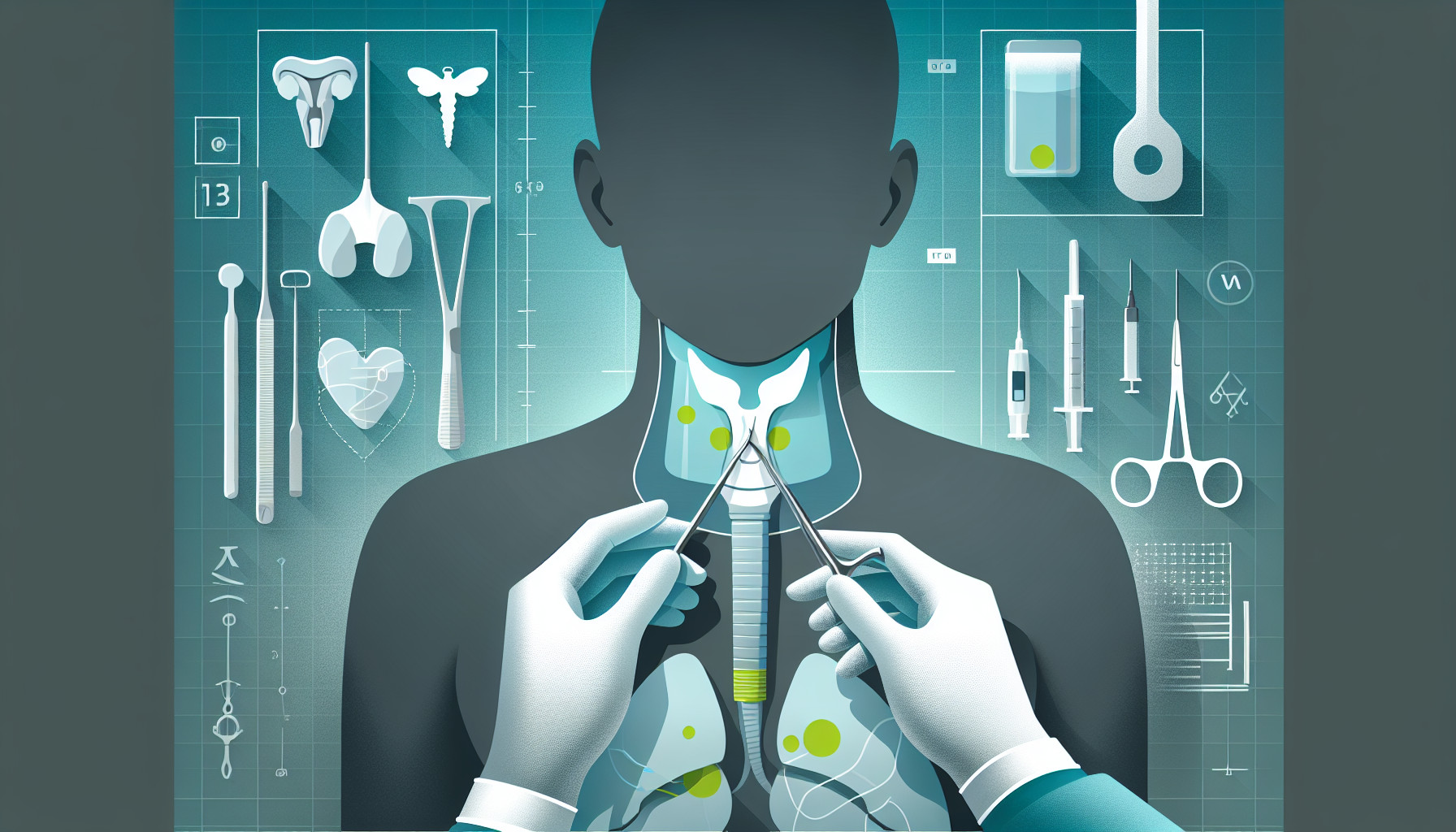Our Summary
The research paper is about a new surgical procedure for removing thyroid glands, known as Transoral Endoscopic Thyroidectomy Vestibular Approach (TOETVA). This operation does not require visible incisions, which makes it more aesthetically pleasing for patients. The study involved 15 patients, who met certain criteria, including having a thyroid that wasn’t larger than a certain size, and having certain types of benign tumors or non-metastasizing cancer.
The procedure involves inserting three ports (small openings for surgical instruments) in the mouth, and using an endoscope (a tube-like instrument with a light and camera) and other instruments to remove the thyroid. Carbon dioxide is used to inflate the area and make it easier to operate.
Out of the 15 patients, some had their whole thyroid removed, while others only had part of it removed. The average operation time ranged from about 60 to 135 minutes, depending on what was done. One patient had a temporary drop in calcium levels after the operation, but there were no other complications.
In conclusion, this is the first time this procedure has been performed in Italy and the results are promising. The patients were happy with the cosmetic results, and the researchers are hopeful that this procedure will be more widely used in the future.
FAQs
- What is the Transoral Endoscopic Thyroidectomy Vestibular Approach (TOETVA)?
- What were the criteria for patients eligible for the TOETVA procedure in this study?
- What were the outcomes and complications from the procedure among the 15 patients involved in the study?
Doctor’s Tip
A helpful tip a doctor might give a patient undergoing a thyroidectomy, particularly a Transoral Endoscopic Thyroidectomy Vestibular Approach (TOETVA), is to follow post-operative care instructions carefully. This may include taking prescribed medications, monitoring for any signs of infection or complications, and attending follow-up appointments with the surgeon. It is also important for the patient to maintain good communication with their healthcare team and report any concerns or changes in symptoms promptly. By following these guidelines, patients can help ensure a successful recovery and optimal outcomes following thyroid surgery.
Suitable For
Patients who are typically recommended thyroidectomy include those with benign tumors or non-metastasizing cancer of the thyroid gland, as well as those with hyperthyroidism or Graves’ disease that does not respond to other treatments. Additionally, patients with large goiters or nodules that are causing symptoms such as difficulty breathing, swallowing, or speaking may also be recommended for thyroidectomy. The decision to undergo thyroidectomy is usually made by a team of healthcare providers, including endocrinologists, surgeons, and other specialists, based on the individual patient’s medical history, symptoms, and the results of diagnostic tests.
Timeline
Before the thyroidectomy:
- Patients undergo a series of tests and consultations with their doctor to determine if they are suitable candidates for the surgery.
- They may need to stop taking certain medications and follow specific dietary guidelines in the days leading up to the procedure.
- On the day of the surgery, patients are typically admitted to the hospital and prepared for the operation.
After the thyroidectomy:
- Patients are monitored closely in the immediate post-operative period for any signs of complications such as bleeding, infection, or changes in calcium levels.
- They may need to stay in the hospital for a day or two for observation and pain management.
- After discharge, patients are instructed on how to care for their incision site and manage any post-operative symptoms such as fatigue or changes in voice quality.
- Follow-up appointments are scheduled to monitor thyroid hormone levels and overall recovery.
Overall, the timeline for a patient undergoing a thyroidectomy can vary depending on the individual’s health status and the extent of the surgery, but typically involves thorough pre-operative preparation, a relatively short surgical procedure, and a period of recovery and monitoring post-operatively.
What to Ask Your Doctor
- What are the potential risks and complications associated with a thyroidectomy using the TOETVA approach?
- How does the recovery process differ compared to traditional thyroidectomy surgery?
- Will I need to take any medications or supplements after the surgery to support thyroid function?
- What follow-up care or monitoring will be necessary after the procedure?
- Are there any specific dietary or lifestyle changes I should make post-surgery?
- How long will it take for me to fully recover and resume normal activities?
- Are there any restrictions on physical activity or lifting after the surgery?
- How will my voice be affected by the surgery, and are there any potential risks to my vocal cords?
- What are the long-term effects of having all or part of my thyroid removed?
- Are there any alternative treatment options available for my condition that I should consider before proceeding with a thyroidectomy?
Reference
Authors: Dionigi G, Bacuzzi A, Lavazza M, Inversini D, Boni L, Rausei S, Kim HY, Anuwong A. Journal: Updates Surg. 2017 Jun;69(2):225-234. doi: 10.1007/s13304-017-0436-x. Epub 2017 Apr 12. PMID: 28405949
